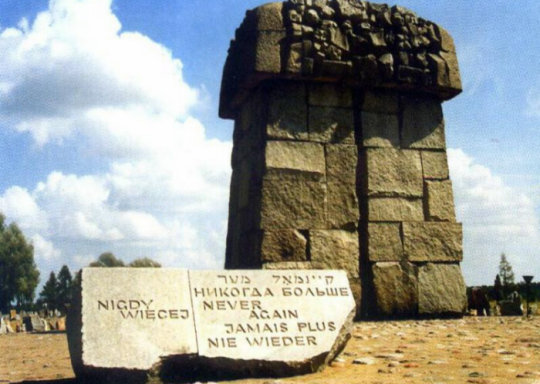The Nazi Politics of Racial Discrimination and Extermination - Forms of Memory in the Arts of Eastern Europe
|
|
||

Ты видел все. Запомни и живи. (И. Эренбург)
You have seen everything. Preserve the memory and live.(I. Ehrenburg)
In the winter semester of 2001/2002 the Institute of Slavonic Studies of the University of Heidelberg (Professor Urs Heftrich), in close cooperation with the Institute of Eastern European History (Professor Heinz-Dietrich Löwe and Frank Grüner M.A.), started a research project entitled The Nazi Politics of Racial Discrimination and Extermination - Forms of Memory in the Arts of Eastern Europe. The subject of this interdisciplinary and comparative research project is the form and content of historical memory as it has manifested itself in fiction, poetry, journalism, film, music and the performing and visual arts of different countries and cultures in Eastern Europe from the thirties of the Twentieth Century up to the present. Whereas the holocaust literature of Western Europe and the USA has been the subject of a number of studies, the representations of the Nazi politics of racial discrimination and extermination in the literature and film of Eastern Europe with all their variations in content and artistic form have received comparatively little attention in the respective countries of Eastern Europe themselves as well as in Western Europe and the USA. This deficit in research as well as in the general perception can be explained - at least as far as the situation in the countries of Eastern Europe before the political changes from 1989 to 1991 is concerned - mainly by the extensive taboo imposed on the subject by the socialist regimes of Eastern Europe. Upon closer examination, however, considerable differences can be found in the way the different states and regimes have dealt with the topic. Thus a very exciting interdisciplinary field of research presents itself in which fundamentally new insights are to be expected with regard to the artistic forms of representation and the historical conditions under which the works of art developed as well as with regard to the social and political structures and processes in general. Some central questions and aspects which may outline our research interests are:
These questions were also discussed at an international symposium which took place from 29th October to 2nd November 2003 at the University of Heidelberg. It was organised by the Institute of Slavonic Studies and the Institute of Eastern European History in co-operation with the „Internationales Wissenschaftsforum Heidelberg“ and mainly financed by the Fritz-Thyssen-Stiftung (see also programme and report on the symposium). The conference served the purpose of bringing together literary scholars, historians, art-historians and musicologists from different countries in order to take stock of the achievements of research up to now and to intensify the beginning co-operation with leading research institutes in Russia, Middle and Eastern Europe, the USA, Canada and Israel. The papers of the conference were published in 2006 in the anthology "Zerstörer des Schweigens". Formen künstlerischr Erinnerung an die nationalsozialistische Rassen- und Vernichtungspolitik in Osteuropa. Edited by Frank Grüner, Urs Heftrich and Heinz-Dietrich Löwe. Cologne, Weimar, Vienna: Böhlau 2006. In the winter semester of 2002/03 the new research focus was already represented in the lecture programme of the Institute of Slavonic Studies of the University of Heidelberg. In two introductory seminars on „Holocaust and Soviet literature“ (Frank Grüner, M.A.) and on the works of the Polish poet „Tadeusz Rózewicz“ (Dr. Stahl-Schwaetzer) the students had the opportunity to study and discuss different representatives and forms of literary memory of the Nazi politics of racial discrimination and extermination in Russian and Polish literature. Other lectures and seminars took place in the summer semester of 2003, for example a lecture on “National Socialism as reflected in Czech literature” with an accompanying seminar on “ National Socialism as reflected in Czech films” (Professor Urs Heftrich). In the summer semester 2004 Frank Grüner held an interdisciplinary seminar entitled “Jewish ghettos in Eastern Europe (Warsaw, Wilna and Minsk) during the Nazi occupation: organization, everyday life, terror and resistance in historical sources and literary portrayals”, which was attended by students of the Institute of Eastern European History as well as at the Institute of Slavonic Studies. More lectures and seminars on other aspects of the research topic are being planned. In the summer semester 2005 both institutes organised an international research colloquium entitled "How much misery and hunger! How much grief, how many paths to go!" - The Nazi Politics of Racial Discrimination and Genocide of the Sinti and Roma - Memory in the Arts of Eastern Europe". Renowned researchers from a number of countries were invited to this colloquium. In view of the wide range of themes and the significance of the subject for the study of the literature and cultures as well as of the political and social developments in the history of the different countries of Eastern Europe the Institute of Slavonic Studies and the Institute of Eastern European History are planning to establish a long-term research focus on the subject „The Nazi Politics of Racial Discrimination and Extermination - Forms of Memory in the Arts of Eastern Europe“ at the University of Heidelberg. They will apply to sponsors for financial support for this project. If you have any further questions or suggestions regarding this research project at the University of Heidelberg, please contact: Felicitas Fischer von Weikersthal, M.A. Slavisches Institut Universität Heidelberg Schulgasse 6 D-69117 Heidelberg Tel.: ++49/6221/542628 Fax.: ++49/6221/543105 E-Mail: urs.heftrich@slav.uni-heidelberg.de |

